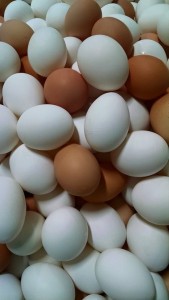Produce Notes: First glance at corn for the season. Only a limited number of shares though so I would add those early. We will have more to come.
The flavors of New Mexico this week look like this: Tomatoes, Romaine lettuce, Zucchini, Cucumbers, Red bell peppers, Kale, and Cantaloupe.

A Mexican Street Food Feast:
Grass-Fed NM Barbacoa Tacos, Mexican Street Corn,
Fresh Garden Salad and Pineapple Agua Fresca

For many farmers, June means the start of the farmers’ market season. Long days harvesting, followed by getting up at the crack of dawn, followed by crossing your fingers that someone will actually show up that day and buy the produce that you have lovingly grown for months. I used to love farmers’ markets. Every week was like a gamble. You had a great day or you had a terrible day. It was (is) a very manic way to make a living. Unfortunately, farmers’ markets are about the most unsustainable way to market sustainably-grown food. Let me walk you through this.
As a starting out farmer, you almost feel like you have to sell at the farmers’ markets. It is a rite of passage in a sense. All the cool kids are doing it so you better buy a tent and join the circus. So you do. But then an old farmer walked up to me when I was selling at the U District market in Seattle and brought my moment of clarity in one question. He said “Do you know who the biggest winner is at the farmers’ market?” Then he pointed to a box truck from the local food bank that was filled to capacity as farmers donated all of the produce they could not sell during the market.
I was 25 at the time and thought he was just being cynical. But week after week I saw that same truck from the food bank drive off completely full. Don’t get me wrong, it is great that it went to the food bank where someone would enjoy the fruits of growers’ labor, but the farmers got nothing for it. Nada. And as I prepared to break ground on my own farm in my native NM, I had to ask myself if farmers’ markets would be a viable way for me to run the business?
And the answer was a resounding No. How can you run a financially sustainable business when you have no consistent sales, no year-round income, and no promise that the weather will be nice enough for people to come out. I mean, you not only have to worry if the weather will allow you to grow healthy crops, but now you have to worry about the weather driving customers away? That is too much risk.

So starting the farm in 2003, I put all of my proverbial eggs into the CSA basket. I needed a consistent way to sell my produce even if it meant that the numbers were low to begin with. So we launched the CSA with 17 people our first week. The members doubled to 34 by the second week and just like that our CSA venture shot out of the gate like a rented mule.
And here is the most important part of this decision to just focus on the CSA; it meant that I had more time to farm. I was not spending time standing around in a parking lot hoping to sell my food. I was able to spend my time farming and not selling. I mean this is the conundrum of the farmers’ markets isn’t it? If you want to sell more food, you have to go to more markets, which inherently means that you will lose more time growing food. Are you a farmer or a marketer?
So just as growers are trying to answer that question, the USDA comes along and funds/incentivizes the expansion of farmers’ markets. Instead of trying to bring more shoppers to existing markets, the goal became to provide grant money to increase the numbers of farmers’ markets. So downtown ABQ went from having 1 really successful market, to having 4 lame markets. It doesn’t take an economist to realize if you divide the markets by 4 without bringing any new customers to the table, you end up worse off than you started.
I have to tell you that this is what I love about the CSA model; our business is driven by you and not contingent or dependent on the whims of a grant. We have grown with your support and we have been fortunate enough to bring other local suppliers onto our team with your support. This is how a sustainable local food landscape should look.
And if you find yourself at a farmers’ market this season, buy some food. Too often markets get over-run with musicians and face painters and you almost lose track of why the market exists. The market’s purpose is to sell food. It is not a dog park where you can buy a cup of coffee and burrito.
My hope is that some of these markets will close down soon and we can get back to a point of having more concentrated support for growers at a small handful of locations, rather than diluted unsustainable sales on every street corner.
Farmer Monte